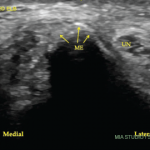 SAN DIEGO—In the Curbside Consults session at ACR Convergence 2023, experts provided overviews of, and insights into, ulcers, nerve entrapment and autoimmune-related hearing loss.
SAN DIEGO—In the Curbside Consults session at ACR Convergence 2023, experts provided overviews of, and insights into, ulcers, nerve entrapment and autoimmune-related hearing loss.
Oral Uclers
During his presentation, Haner Direskeneli, MD, chief of rheumatology at Marmara University School of Medicine, Istanbul, discussed the need to differentiate between ulcer types and causes, as well as treatment strategies.
Dr. Direskeneli described the case of a 45-year-old, male physician who’d had recurrent oral ulcers for 10 years, with unsatisfactory treatment results. The patient eventually saw a dermatologist and was diagnosed with herpes zoster. Treatment with an anti-viral completely healed him in a week. The lesson is simple: “Not all oral lesions are aphthous ulcers,” he said.
Acute, immune-mediated lesions of the oral cavity may be a better term for oral lesions, Dr. Direskene suggested. Oral lesions can come in many forms, including erythema multiforme, burning or itchy pink papules and pemphigus, which is seen as irregular ulcerations. Recurrent oral ulcers or aphthous stomatitis are well-circumscribed, often depressed lesions with an epithelial defect covered by a fibrin clot, causing a yellowish-white appearance.
Systemic disorders that involve aphthous-like ulcers include nutritional diseases; immunocompromised states, such as HIV; rheumatic diseases, such as Behçet’s disease, reactive arthritis and lupus; gastrointestinal diseases, such as inflammatory bowel diseases and gluten-sensitive enteropathy; and hematologic disorders, such as cyclic neutropenia.
Behçet’s disease ulcers can’t be readily distinguished from other recurrent aphthous stomatitis. “You cannot define the underlying cause by only looking at the ulcers,” Dr. Direskeneli said. Non-specific signs of Behçet’s are oral ulcers, erythema nodosum and anterior uveitis. More specific signs are genital ulcers, posterior uveitis or retinitis, vascular manifestations and central nervous system involvement.
In patients with systemic lupus erythematosus (SLE), oral ulcers have been seen in 7–52% of cases. Irregular, painless ulcers are most commonly seen in the buccal mucosa and the hard palate, and are associated with general disease activity.
Inflammatory bowel disease, MAGIC (i.e., mouth and genital ulcers with inflamed cartilage) syndrome, PFAPA (i.e., periodic fever, aphthous stomatitis, pharyngitis and adenitis) and A20 haploinsufficiency are other systemic inflammatory disorders associated with the ulcers.
Ulcers lasting more than three weeks should be assessed for possible malignancy, Dr. Direskeneli noted.
Patient Care
Topical treatments are the first choice for recurrent oral ulcers, but they don’t prevent future recurrence. Colchicine is the first systemic choice, Dr. Direskeneli said. In his opinion, azathioprine can be the first choice for difficult-to-treat cases. Apremilast may be a safer and more effective option and is approved by the U.S. Food & Drug Administration for recurrent oral ulcers of Behçet’s disease. However, insurance reimbursement issues may limit its use.
Biologics, such as anti-tumor necrosis factor, anti-interleukin (IL) 1, anti-IL-12 and anti-IL-17 agents, can be used in the most refractory cases, Dr. Direskeneli said.1
Oral hygiene is also crucial. Patients with recurrent oral ulcers tend to have impaired dental and periodontal health. One study showed that a mechanical hygiene intervention produced a greater reduction in ulcers in patients at six months than no intervention in control subjects.2
The use of short-term azithromycin to improve oral health can have a beneficial effect, Dr. Direskeneli notes.
Nerve Entrapment
Chris Doughty, MD, clinical director of Neuromuscular Neurology at Brigham and Women’s Hospital, Boston, and assistant professor of neurology at Harvard Medical School, addressed nerve entrapment. He said the key to managing cases of nerve entrapment is to avoid axonal damage by relieving the compression early.
“It’s useful for you, as rheumatologists, to be able to recognize some of these syndromes and act on them quickly,” he said.
The most common nerve entrapment condition is carpal tunnel syndrome. Patients with rheumatoid arthritis and psoriatic arthritis—and to some extent Sjögren’s disease—have carpal tunnel syndrome due to structural changes to the carpal tunnel.
Dr. Doughty noted some diagnosis pitfalls to watch out for in nerve disorders. Often, symptoms are seen in all five fingers, with pain frequently reaching into the forearms. This presentation isn’t helpful to localize the problem because the forearms are outside the territory of the median nerve that is involved in carpal tunnel syndrome. Commonly used maneuvers, such as Tinel (i.e., tapping the carpal tunnel) and Phelan test (i.e., touching the backs of the wrists together), may be more sensitive to tenosynovitis. Therefore, these maneuvers wouldn’t help distinguish carpal tunnel syndrome, he said.
Clinicians can definitively identify involvement of the median nerve if a patient has numbness on the lateral aspect of the fourth digit and normal sensation on the other side of that finger. They can identify that it’s carpal tunnel if there is numbness that spares the area at the base of the thumb. This is virtually diagnostic for carpal tunnel syndrome.
Electromyography and nerve conduction studies can be helpful in localizing the problem, identifying concurrent issues that may also be contributing to symptoms and assessing severity, Dr. Doughty said.
Patient care: Management is guided by the severity of the condition. Patients should begin by avoiding activities that bring on symptoms. Patients can also try occupational therapy and wearing a wrist splint, especially at night when bending may aggravate symptoms, Dr. Doughty said.
In the short term, corticosteroid injections can help, but their risks for long-term use are well known. For severe cases, surgery has been found to resolve symptoms, either completely or almost completely, about three-quarters of the time.
Dr. Doughy added that weakness or atrophy is “an indication to act fast. Don’t wait on a referral to orthopedic or plastic hand surgery.”
The Inner Ear
Andrea Vambutas, MD, chair of otolaryngology at the Zucker School of Medicine at Northwell Health/Hofstra University, Hempstead, N.Y., addressed autoimmune inner ear disease (AIED). She noted the understanding of AIED has followed a pattern similar to other diseases.
“More and more, we’re seeing a number of different autoimmune diseases being reclassified as autoinflammatory diseases based on some of the characteristics we see. … There are a lot of paradigm shifts that we’re beginning to see,” said Dr. Vambutas.
Muckle-Wells syndrome is an example of an autoinflammatory disease that causes sensorineural hearing loss, among other clinical findings.
Evidence exists that AIED has features similar to autoimmune disease, including cochlin-specific Th17 cells and high titer, anti-cochlin antibodies. However, the general lack of autoantibodies, the low-titer autoantibodies and the dysregulation of interleukin (IL) 1 and TNF support an autoinflammatory phenotype. No clear biomarker exists for AIED. Laboratory testing is not of much value because no antibodies have been found to be robustly or uniquely positive across patients.
Although two studies found that systemically administered anti-tumor necrosis factor (TNF) medication did not benefit patients with AIED, locally administered anti-TNF medication given to patients with AIED who were steroid-dependent benefited patients in two small series.3,4 Also, N-acetylcysteine produced good results when combined with glucocorticoids in another study of sudden sensorineural hearing loss, Dr. Vambutas said.5
Dr. Vambutas and colleagues are conducting a phase 2 clinical trial examining the IL1-antagonist anakinra in patients with glucocorticoid-resistant AIED. The study will include three groups: one that will take anakinra followed by placebo, one that will take placebo followed by anakinra and one that will take only anakinra over 84 days.
According to Dr. Vambutas, outside clinical trials, about 40% of patients with AIED who are glucocorticoid-resistant had hearing improvement with anakinra, while about 73% of patients who are glucocorticoid-dependent did. Of the 28 patients who were glucocorticoid-resistant, only one of six patients with elevated C-reactive protein improved while taking anakinra.
Some patients who had been previously glucocorticoid-resistant, for whom IL-1 inhibition with anakinra failed, later responded to glucocorticoids, which is an interesting phenomenon, Dr. Vambutas noted.
“There seems to be a steroid-responsive switch in patients with AIED [in which] high TNF levels seen experimentally correlated with steroid sensitivity; whereas high IL-1 levels seen experimentally were associated with clinical steroid-resistance,” she said
Thomas Collins is a freelance medical writer based in Florida.
References
- Fagni F, Bettiol A, Talarico R, et al. Long-term effectiveness and safety of secukinumab for treatment of refractory mucosal and articular Behçet’s phenotype: A multicentre study. Ann Rheum Dis. 2020 Aug;79(8):1098–1104.
- Karacayli U, Mumcu G, Simsek I, et al. The close association between dental and periodontal treatments and oral ulcer course in behcet’s disease: A prospective clinical study. J Oral Pathol Med. 2009 May;38(5):410–415.
- Cohen S, Shoup A, Weisman MH, et al. Etanercept treatment for autoimmune inner ear disease: Results of a pilot placebo-controlled study. Otol Neurotol. 2005 Sep;26(5):903–907.
- Van Wijk F, Staecker H, Keithley E, et al. Local perfusion of the tumor necrosis factor alpha blocker infliximab to the inner ear improves autoimmune neurosensory hearing loss. Audiol Neurootol. 2006;11(6):357–365.
- Pathak S, Stern C, Vambutas A. N-Acetylcysteine attenuates tumor necrosis factor alpha levels in autoimmune inner ear disease patients. Immunol Res. 2015 Dec;63(1–3):236–245.


